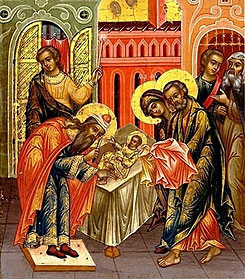Sermon on the Feast of the Circumcision of the Lord
Bishop John of Caracas and South America
 Today we continue to celebrate Christmas. Although the leave-giving of the Feast of the Nativity itself has already passed, today we celebrate the feast which, according to the Gospel, is connected with the Nativity – the Circumcision of the Lord. Today we continue to celebrate Christmas. Although the leave-giving of the Feast of the Nativity itself has already passed, today we celebrate the feast which, according to the Gospel, is connected with the Nativity – the Circumcision of the Lord.
The Lord was fulfilling the old law, and so on the 8th day after His Nativity, according to the old law, according to the Jewish custom, He was circumcised and given a name. And tomorrow begins the forefeast of the Theophany – the Baptism of the Lord. This is also a continuation and part of the whole holiday season.
In antiquity, until the 4th century, the Church celebrated the Epiphany together with Christmas, as Armenian Christians still do. It was one feast, but first in the West, and then in the East, under St John Chrysostom, the feast was divided into two parts, so that it would be possible to concentrate on both Christmas and Epiphany. Naturally, both events took place on the same day, as we read in the Gospel: the Lord, when He was 30 years old, came and was baptized by John. In addition, in the Old Testament, a priest began his ministry at the age of 30, just as a rabbi, that is, a teacher, also began his ministry at the age of 30. Therefore, it is natural that when the Lord was baptized on His Birthday, He began His earthly preaching.
Of course, they lived according to the Old Testament calendar, which was the lunar calendar. And if you look at the Gregorian or Julian calendar, then feast days became movable, and there could be a whole month of difference in different years.
We see this happening with Passover, which we continue to celebrate according to the Old Testament calendar, through which it is connected to the Jewish Passover, and thus, as we know, the timing of Passover changes. It was the same during the earthly life of our Lord Jesus Christ, and in early Christian times – feasts were celebrated according to the Old Testament calendar.
But there are such churches, especially Protestant ones, as well as atheists, who try to mock Christ, and they say that the feast of the Nativity of Christ was simply started by Constantine the Great, and that it is a pagan holiday. Nothing of the kind is true!
First of all, it is known that Christians have always been very averse to pagan holidays, and as I have already mentioned, Christmas began to be celebrated together with the Epiphany, and this was on the 6th of January, and only then was Christmas moved to the 25th, 12 days earlier, so that people could celebrate more. And there is no connection with the solstice, which occurs on December 23.
Although we do not insist that this is the exact historical date of Christmas, nevertheless we still celebrate the coming of our Lord Jesus Christ, the Son of God, into this sinful world to save us, and how can we not celebrate it?
But there is reason to think that it could have been completely different, given that it was then celebrated according to the Hebrew calendar, and there could have been a whole month difference. However, in the Dead Sea Scrolls, they found the schedule of the priests in the Temple – because the Qumran brothers were very interested in the service in the Temple in Jerusalem. They dreamed of resuming worship there in truth, since they considered the one that existed at that time to be defiled – and so, they gathered information and found it – about the distribution of the ministry.
As we know from the book of Leviticus in the Old Testament, all priests were divided into 24 ranks. And from the Gospel of Luke we know that the prophet Zechariah was from the family of Abijah, and since there were 24 families in total, each group served for a week twice a year. We now know from the scrolls that the priest Abijah was serving somewhere at the end of our month of September, when we celebrate the conception of John the Baptist!
So, if all this is connected, then the Annunciation, that is, the Conception of our Lord Jesus Christ, falls somewhere at the end of March, and then, accordingly, Christmas falls at the end of December!
And one more thing: Roman bureaucracy was orderly, so it is natural that the census was most likely for the Roman New Year, i.e. January 1.
So do not listen to the enemies of the Church who want to darken our celebration. Even if our dates are not historically accurate, we still commemorate the fact of the coming of our Lord Jesus Christ into the world and His Theophany. Let us first note His appearance to a narrow circle, when He was born, and 30 years later He appeared to all people, began His earthly preaching, suffered for us, and rose again!
Delivered on January 14, 2024 at the Cathedral of the Resurrection in Buenos Aires, Argentina.
iglesiarusa.info
|